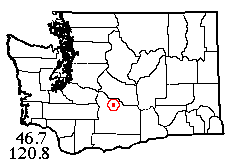
Spider Collector's Journal (4th page: 1992) Copyright © 2005 by Rod Crawford
As explained on the first page, most of these notes of fun (and not so fun) trips to collect spiders for research at the Burke Museum appeared in Scarabogram, newsletter of "Scarabs: The Bug Society," in their original forms. References to the editor mean me; most other persons mentioned are Scarabs members. Dates of field trips head each paragraph. Maps showing the location of sites within Washington state follow the grid system outlined in the Washington Spider Checklist. RETURN TO INDEX
1992 was my most productive field year in Washington ever, with all or part of 44 days spent in the field, in part because of the spray-area moth inventory project. Many of the destinations were determined by a) an agreement with the state Natural Area Preserves (NAP) program to collect spiders at various "special" sites, and b) my recent keen interest in collecting in bogs, especially Sphagnum bogs, which I located largely with the help of the "bog bible," G.B. Rigg's Peat Resources of Washington. You might say I was "really into bogs." About 6,000 spider specimens were collected this year with help from student assistants Gil Matos and Song Choe.
 |
29 II 1992: As this is typed, yr editor has been collecting only once in this most unusual winter: on Leap Day, Feb. 29. That trip, courtesy of Scarab Bob Zahler, who was going to a meeting in the area, was to lower Oak Creek, a tributary of the lower Tieton River in western Yakima County. For 6 hours collecting, the yield was 28 spider species, excellent for eastern Washington in February, and including one species I didn't previously have. Besides the usual habitats of vegetation, oak and cottonwood litter, and under rocks, I wanted to try checking under the scales of pine bark for two species that are supposed to live there. That didn't work out, but the claw hammer I brought along proved an excellent tool for stripping off dead oak bark, revealing 5 interesting species living in this unusual habitat.
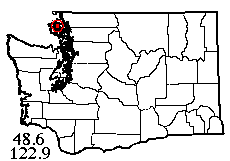 |
14 III 1992: On March 14, my friend Joyce and I took the ferry to Orcas Island, visiting an oak savanna area on south Turtleback Mountain and a notable Sphagnum bog at Killebrew Lake. Though the oak area, on private land, was highly touted in a "Natural Landmarks" report, the section we visited proved unspectacular, but among the 22 spider species was one new state record. The bog, on the other hand, was especially nice, and the 25 spider species taken (mostly from moss on the floating mat) included 4 new. Sphagnum in wet bogs tends to be so soggy you wouldn't think anything terrestrial could live in it, but in fact it proves to be the most productive of all spider habitats; a large handful can produce so many, it's hard to catch them all before they run off the sifting cloth.
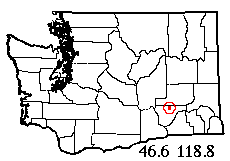 |
25 III 1992: On March 25, in a 13-hour marathon, my student helper Gil Matos and I went all the way to Walla Walla and back (600 mile round trip) with the museum van to pick up the spider collection formerly belonging to Walla Walla College (a private school) which has been dispersing its former natural history museum (the insects went to WSU primarily). There were 630 vials of spiders, expected to yield some interesting records when I get them re-identified. We also got mites and ticks (61 vials and 253 microscope slides), fleas, and protura. An especially notable find was the original specimens on which the 1932 Washington record of the crab spider species Philodromus satullus was based. They were misidentified, so that species can be deleted from the state list. En route, we took a one-hour break collecting in Esquatzel Coulee, near Connell, Franklin County. This yielded 10 species, including an undescribed spider previously known from one specimen collected elsewhere along the same coulee, 10 years before! Also an especially early specimen of the butterfly Papilio oregoneus. [Now it can be told: Gil got a speeding ticket near Cle Elum on the way home!]
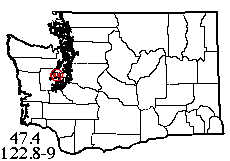 |
28 III 1992: On March 28, former Scarab Rick Sugg and I went to the southern Kitsap Peninsula to visit Oak Patch NAP and do some bog-hunting. The Oak Patch site, only sizable stand of oaks in the area, produced 31 spider species in 4 hours, but no surprises; indeed, all the species collected were such as might have re-invaded the area after a "prescribed burning" whose effects were still evident. Of 7 state NAP sites visited this year, Oak Patch was the only disappointing one. In the afternoon, taking the "bog bible," we looked for some Sphagnum bogs supposed to be in the vicinity. The most promising one had been drowned by beavers, some were unfindable, and others had been excavated, but we finally found one (Belfair Bog No. 2) in good condition. A hastily gathered Sphagnum sample yielded only 13 species, but including 2 new.
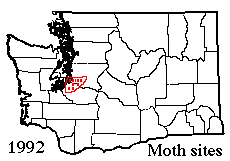 |
3-30 IV 1992: This was the year of the first (and to date largest) mass spraying of Bacillus thuringiensis, which kills most caterpillars, by the state Department of Agriculture to eradicate Asian Gypsy Moth. Scarabs Pelham, Crabo and Crawford were invited to comment on the proposed spraying of 130,000 acres, and suggested it would at least be nice to find out what species of native moths were being killed before they were gone. My proposal to do the study was funded, and I temporarily became a moth collector. Needing a field partner, I recruited Scarab Jerry Austin, an experienced moth-er. The plan was to collect within the spray area for ten nights at different sites with a variety of good (up to now) moth habitats, using Scarab Crabo's powerful mercury vapor light and generator, collecting all moths that showed up within a 4-hour period. Spraying was in progress, and our schedule was set to stay one jump ahead of the sprayers. 11 nights of April (including one rained out) were devoted to this project, but on 4 of these nights I collected some spiders also, largely by way of filling out distribution data. All 4 collections yielded one or more unusual spiders, and at Maplewood Spring in Puyallup I got a Tetragnatha new to the state. In all 891 moths were collected; our best night was 241 and our worst, 18. The species total was 105 (68 macromoth and 37 micromoth species). The Big Soos Butterfly Preserve yielded the most species (56, in 158 specimens). Only one species, the noctuid Protorthodes rufula (from Auburn), was considered "rare" by us and of special concern for subsequent spring monitoring.
 |
25 IV 1992: Only one day during April, the 25th, was devoted to a "regular" spider field trip, when Gil and I took a motor pool car to Bald Hill NAP in far eastern Thurston County. The south part of the preserve (south of an impassable ravine) proved to be a really remarkable site, a network of hill-crest prairie-like meadows with exceptional plant diversity in forest of Douglas-fir, madrona, and oak. There are over 200 vascular plant species, 39 of which are the only Thurston County occurrences. The spring flowers were extraordinary! In 5 hours collecting around one small area, we set a new record of 54 spider species for a one-day one-site catch! Best find was Cicurina tacoma, described in the 1940s and not seen again 'til now.
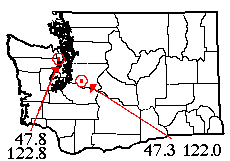 |
2-3 V 1992: In May, every weekend but Memorial Day was spent collecting spiders. On May 2, I went to Dabob Bay NAP with Scarab Pelham to sample the high-quality sandspit habitat. Among the 36 spider species taken were some very unusual salticids (jumping spiders) active on bare patches among the sandspit meadow vegetation. Also recorded were 10 butterfly species, one a Jefferson County record. The next day, Gil and I went to Covington Bog, a large, very beautiful Sphagnum bog sandwiched among the housing developments of the Kent area, which we located during the moth project (45 moth species from the adjacent willow swamp). This bog yielded about 30 spider species, 20 of them from the Sphagnum moss, which also produced 2000 oribatid mites from one bagful. The reason I mention mites is that I have a new arrangement with a chap in Czechoslovakia to trade them for spiders and harvestmen.
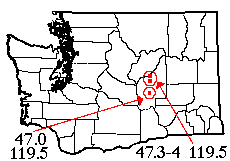 |
9 V 1992: The May 9 trip, with Gil, Rick, and Zoology grad student Louis Provancher, went to Soap Lake, a well-known alkaline lake in the central Columbia Basin, in search of 2 spider species taken there in the 1930s and not found in Washington since then. We visited 2 sites along the shoreline, getting 24 spider species from the first and 17 from the 2nd. The latter site, a Boy Scouts owned area at the SW corner of the lake (revisited July 4 for a total of 34 species), is an outstanding collecting site which I can recommend to other Scarabs. The two species we went there for eluded us, but two other additions to the state list, one a very attractive little crab spider, consoled me. On the way back, a stop at a sand dune area by the Winchester Wasteway produced yet another new species.
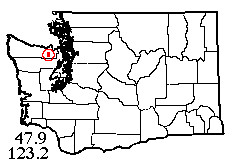 |
16 V 1992: On May 16, Gil, Rick, and I visited a spot in the Olympic foothills south of Sequim, called "Pat's Prairie" in a draft natural landmarks report I dug up. The report implied that the site was a relict botanical community resembling some in the mountains of eastern Washington, so we were surprised to find the large meadowlike clearing was really a Sphagnum bog! Though not what we expected, a 40-species spider sample including some good stuff from the Sphagnum moss made the day very worthwhile. This is a very secluded spot, easy to reach (if you know it's there), and one of the most silent localities I have ever visited.
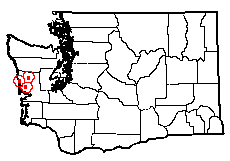 |
30 V 1992: The last field trip in May was on the 30th, to three areas on and near the Washington coast. Gil and I were accompanied by Jeremy Miller, an Evergreen State College student interested in spiders.* First stop was on the beach near Moclips, where we picked up 24 species at the mouth of the Moclips River, including another record for our undescribed sea beach wolf spider, and a range extension for an introduced species formerly found only in Seattle. Next, we visited Carlisle Bog NAP, where the bog habitat proved to be past its prime season, but among the 27 species taken was one new to the state. Last stop, a roadside north of Humptulips, gave a 14-species collection supplementing a previous sample. [*Jeremy went on to work on spiders for his M.S. and Ph.D. in east coast universities.]
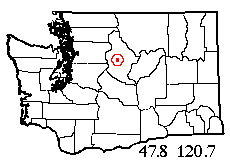 |
6 VI 1992: On June 6, Rick and I took visiting Russian zoologist Dmitri Banin along on a visit to Fish Lake near Lake Wenatchee. Rigg's book says that the west end of the lake boasts the only known Sphagnum bog in Chelan County, but we didn't know how reachable it was. Fortunately, the Forest Service has built a very nice trail along one edge of this large and attractive bog. The Sphagnum fauna was not as good as the samples taken earlier in the year, but at least one state record was among the 33 species taken. Some of the vast Sphagnum mat here is rather "hungry" and caution is advised: you too could be preserved for future anthropologists to marvel at! As I write [mid-July '92] Dr. Banin is participating in a joint U.S.-Russian ornithological expedition in Siberia and has promised to collect some spiders for me! [But as we learned later] he got "bird fever" along with the rest on their arrival, and didn't collect a single spider! Some of the children on the trip tried, but were hampered by the Russian supplies disburser's refusal to give them vials. Consequently, the expedition returned with 2 full spider vials and 148 empty ones! Scarab Pelham did better from the trip, since butterflies don't need vials; over 100 were brought back including 30+ species. The most interesting was Euchloe simplonia, these being the farthest east specimens to date in Asia and a nice link with the first North American record, taken a few years ago by Scarabs Pelham and Crabo in the Yukon.
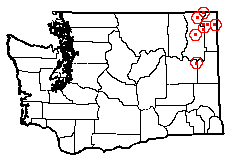 |
20-26 VI 1992. The Stevens County Expedition: Day 1: en route to northeast
Washington, passing through the small town of Edwall, Scarabs Pelham and Crawford
detoured around the parade for the Edwall Mule Festival. We never learned if
the nice young ladies in the main float were the Mule Queen and Mule Princesses.
Spring Creek Canyon NAP in northern Lincoln County, an undisturbed pine canyon
in wheatland, yielded 28 spider species in about 3 hours. Nearby Smeltzer Canyon,
with some boreal flora, produced 4 butterflies new to the county, and a fifth
confirming a previous questionable record. We camped at Rocky Lake south of
Colville (26 spider species there, one new to the state).
Day 2: we reached
Cedar Lake on the Canadian border, a sedge fen peat bog and a classic spider
locality I'd long wanted to visit, and camped on nearby Silver Creek in mesic
forest. The side of Cedar Lake we were able to reach is rather human-altered,
but still has some tall grass meadow, and the pitfall traps yielded well. These
sites combined produced 49 spider species, at least 2 new for the state. Moth
collecting at Silver Creek was good, including the seemingly bat-sized Pachysphinx.
Day 3: we collected
at a beautiful montane pond and wetland on Bodie Mountain, owned by a pair of
aging hippies who live in a cabin and consider their land an "all life
sanctuary." We had to talk fast to get collecting permission, but got 33
spider species including 1 new for the state; also the second state record of
the large jumping spider Phidippus borealis. We met Jon (noted lepidopterist)
and Sigrid Shepard at Northport, and camped with them at Flodelle Creek Campground
on the Little Pend Oreille River. More moth collecting at night.
Day 4: The
Shepards left. I collected 40 spider species (including 4 new) at the Little
Pend Oreille NAP, a willow and bog-birch swamp with Sphagnum growing
around the shrub bases, plus sedge fens and a flowery butterfly meadow which
proved a new locality for State Sensitive species Boloria selene. A superb
spot; those folks in the NAP program can really pick 'em! Our second night at
Flodelle Creek Camp was the best of the trip for moths. But a stonefly attracted
to the moth light flew into Pelham's ear, and bugged him for the rest of the
trip.
Day 5 was spent
by me at Lost Creek Bog, a raised Sphagnum bog of eastern North American
type, in Colville National Forest. The bog was so big I could have got lost
in it if not for my compass, and another really beautiful spot. Also productive:
35 spider species including 2 new for the state, plus more B. selene
butterflies. One of the new spiders here was a relatively enormous (for Washington)
wolf spider called Arctosa raptor, known mainly from northern Canada!
By this time, Pelham had 2 more new county butterfly records for Stevens County.
On our way east from here, I bathed in Sullivan Lake, where I forgetfully left
my hat and watch.
Day 6: our target
was Bunchgrass Meadows, a high elevation (5000'), large wetland/meadow/bog close
to the Idaho border, which is the only Washington site for a mammal, the eastern
bog lemming. We had looked forward to this site all week but it proved disappointing;
also the first campsite of the trip with mosquitoes. However, we both did fairly
well on the summit ridge of nearby Monumental Mountain, with good butterfly
range extensions and the only new spider for the day. We abandoned the peak
on the approach of a thunderstorm; retrieved my hat and watch from the lake;
and returned to Flodelle Creek for our last night.
Day 7: homeward,
with a stop near Ellensburg to monitor a colony of the rare butterfly Euphyes
vestris. For the trip, a minimum of 6 butterfly county records, 11 spider
state records. The doctor removing the stonefly from Pelham's ear 2 days later
was amazed when he saved it.
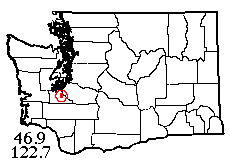 |
10 X 1992: Fall spider season began this month. The October 10 trip to the Spurgeon Creek area in the SW section of Fort Lewis sampled 3 habitats for its 44-species spider total, or 4 including the roadside. The main habitat goal was a sizable grove of lodgepole pine, unusual in this area. Between the road and this grove, the map showed a marsh, so I brought my rubber boots. No need; the drought had made it dry. But little did I suspect that it was overgrown with the most nearly impenetrable willow thicket I've ever entered! Once in, I couldn't go back; the stems pointed the wrong way. Coming back, I picked another spot to cross, figuring it couldn't be worse. I was wrong! With torn clothes and boots, and mostly common species to show for it, I was just glad I hadn't dragged my new student assistant (Song Choe) through that mess. I might have been short one assistant! Fortunately, on the near side of the thicket was a rare example of a sizable stand of Oregon ash trees which produced plenty of species from the litter and understory. The most interesting spider of the trip was collected right beside the road: my second specimen of the weird Argyrodes, which lives as a "thief" in other spiders' webs.
 |
3 X, 11 X, 18 X, 14 XI, 21 XI, 1 XII 1992: Other fall spider trips included a visit to an old growth stand on private property in Marysville, subject of a preservation effort (which seemingly failed). 31 spider species were taken from leaf litter, moss, understory foliage and stumps, but the best specimen was a new centipede species from a rotting snag. My annual spider lecture on Vashon Island concluded with a wet trip to Bank Road Pond, where without really trying we got at least 35 species. A rainy trip into the Cascade foothills ended at Snoqualmie Bog NAP, where not much could be sampled except the Sphagnum but this produced 17 species including Walckenaeria redneri new to the state. A trip to Mosquito Lake Bog in Whatcom County produced no Sphagnum, for it was all floating in the middle of the lake, but Pleurozium moss at the lake edge yielded some bog spiders which, with grass-sweeping and leaf litter, made a total of 30 species. A short visit to two Sphagnum bogs near Big Lake (Skagit Co.) found one of them very promising for a future trip, and ended by gathering a useful leaf litter sample at Steamboat Slough near Conway. On December 1, Song and I squelched into Black River Swamp (alder and cedar with some lodgepole pine) at the south end of Black Lake (S of Olympia) where foliage, rotten wood, litter, and a little Sphagnum produced 31 spider species.
 |
25 X 1992: On the 25th, Song Choe and I did a return trip to Bald Hill NAP, this time to the north side of the ravine. This place is a real paradise! In two short visits, the spider list for the preserve has grown from 0 to 78 species! The only comparable area from which I have more is the UW campus. The day was too wet for sweeping, so we concentrated on sifting oak litter. Also present are open grassland (on the north side), flower meadows (south side), a wetland area confined between steep cliffs at the ravine bottom, and some very impressive old-growth Douglas-fir and hemlock, which I finally managed to locate on this trip. Unfortunately, just as we were about to leave, Song was attacked by yellowjackets. He must have got some pheromone on him, because one wasp kept returning to him while completely ignoring me. Fortunately, he's still working for me. Even that didn't discourage him!
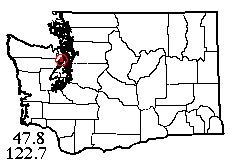 |
5 XII 1992: The last trip of my most productive year was on December 5 with my friend Joyce. We were seeking boggy wetlands on the other side of Puget Sound near Thorndyke Bay, Jefferson County. The side of the bay closest to a road was lined with tree farms, but the timber companies clearly didn't want any recreation interfering with their tree farming, for no-trespassing signs were everywhere. Finally we found a trail with no sign, leading to the bay. On the shore of a large tidal marsh (extensively beaver modified), there was a nice dry area diked by a large log that made a great table for sifting leaf litter, which with a little vegetation sampling produced 29 species. On returning to the car, we saw the sign we'd unknowingly violated, turned around to face the bay!
This page last updated 21 March, 2025